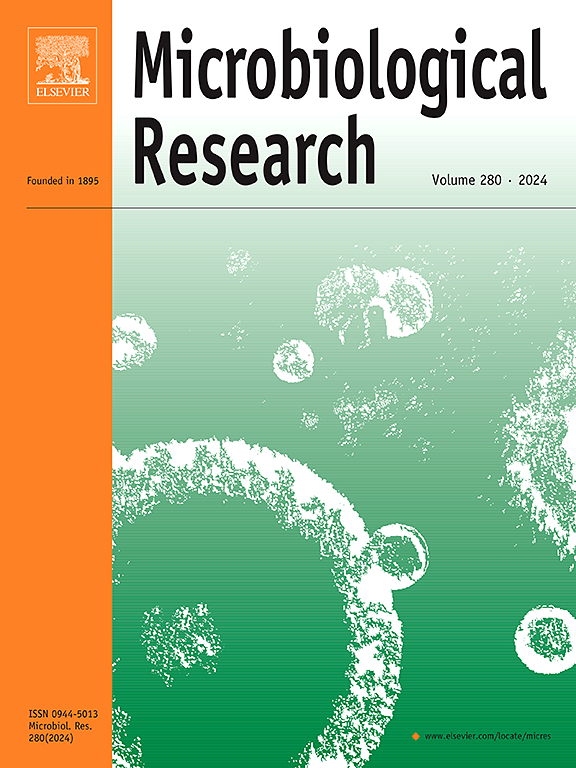盐生植物和嗜盐/耐盐植物生长促进菌在盐碱地修复中的协同潜力:适应机制、挑战和可持续解决方案
IF 6.9
1区 生物学
Q1 MICROBIOLOGY
引用次数: 0
摘要
盐胁迫对农业构成重大挑战,通过引起植物离子和渗透失衡,破坏生理过程,导致土壤退化,从而降低生产力和限制耕地。盐生植物和嗜盐/耐盐(HP/HT)植物生长促进菌(PGPB)通过多种机制适应极端环境,包括离子稳态、渗透平衡和相容溶质的产生,为缓解盐胁迫和改善植物生长提供了可持续的解决方案。然而,对它们的协同作用和特定的盐适应策略的了解仍然有限,阻碍了它们在盐碱地修复中的应用。本文综述了盐生植物和HP/HT PGPB的耐盐机制,重点介绍了它们在盐环境中的相互作用和表现。盐生植物和HP/HT PGPB通过离子稳态、渗透保护和植物激素调节等多种机制增强植物对盐胁迫的适应能力。根系分泌物、化学信号和激素调节促进了它们的协同相互作用,对优化盐渍土修复和植物生长至关重要。该综述还概述了利用盐生植物相关的HP/HT PGPB来有效提高植物耐盐性的挑战,讨论了通过多组学方法、基因工程、机器学习辅助生物信息学、化学计量学和合成生物学在可持续农业中的潜在进展。这些综合策略对盐胁迫耐受机制提供了有价值的见解,为盐生植物- hp /HT PGPB协同作用在盐碱地修复和增强植物抗逆性方面的创新应用铺平了道路,突出了它们在促进长期农业可持续性方面的作用。本文章由计算机程序翻译,如有差异,请以英文原文为准。
Synergistic potential of halophytes and halophilic/halotolerant plant growth-promoting bacteria in saline soil remediation: Adaptive mechanisms, challenges, and sustainable solutions
Salinity stress poses significant challenges to agriculture, reducing productivity and limiting arable land by causing ionic and osmotic imbalances in plants, disrupting physiological processes, and leading to soil degradation over time. Halophytes and halophilic/halotolerant (HP/HT) plant growth-promoting bacteria (PGPB) offer sustainable solutions to mitigate saline stress and improve plant growth due to their adaptation to extreme environments through various mechanisms to tolerate high salinity, including ion homeostasis, osmotic balance, and the production of compatible solutes. However, understanding their synergistic interactions and specific salt adaptation strategies remains limited, impeding their application in saline soil remediation. This review examines the salt stress tolerance mechanisms of halophytes and HP/HT PGPB, highlighting their interactions and performance in saline environments. Halophyte and HP/HT PGPB demonstrate diverse mechanisms such as ion homeostasis, osmoprotection, and phytohormone modulation to enhance plant resilience to salt stress. Their synergistic interactions, facilitated by root exudates, chemical signaling, and hormone regulation, are vital for optimizing saline soil remediation and plant growth. The review also outlined challenges in utilizing halophyte-associated HP/HT PGPB for effective plant salt tolerance, discussing potential advancements through multi-omics approaches, genetic engineering, machine learning-assisted bioinformatics, chemometrics, and synthetic biology in sustainable agriculture. These integrated strategies offer valuable insights into salt stress tolerance mechanisms, paving the way for innovative applications of halophyte-HP/HT PGPB synergy in saline soil remediation and enhanced plant resilience, highlighting their role in promoting long-term agricultural sustainability.
求助全文
通过发布文献求助,成功后即可免费获取论文全文。
去求助
来源期刊

Microbiological research
生物-微生物学
CiteScore
10.90
自引率
6.00%
发文量
249
审稿时长
29 days
期刊介绍:
Microbiological Research is devoted to publishing reports on prokaryotic and eukaryotic microorganisms such as yeasts, fungi, bacteria, archaea, and protozoa. Research on interactions between pathogenic microorganisms and their environment or hosts are also covered.
 求助内容:
求助内容: 应助结果提醒方式:
应助结果提醒方式:


